Operator assistance devices: Improving safety and efficiency
25 November 2022
Safety is never guaranteed on site. The most important task for smart assistance devices is to serve the operator, minimising the risk of damage to equipment and, more vitally, the danger to people. Niamh Marriott reports
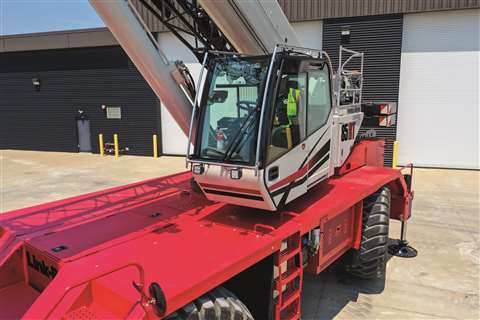 Link-Belt boasts a whole host of assistance devices from cameras to fine metering. (Photo: Link-Belt)
Link-Belt boasts a whole host of assistance devices from cameras to fine metering. (Photo: Link-Belt)
Operator assistance devices come in all shapes and sizes and with increasing functionality and smart features. They can help the operator but they can never guarantee a completely safe lifting experience and job site.
“In our industry, safe is almost a curse word,” says Brian Elkins at Link-Belt. “We want to add features to minimise and mitigate risk.
“We’re giving the operator the ability to have some operator aids that will minimise his chance of an accident but it’s still ultimately in the operator’s hand.
“Safety is obviously the number one priority. But there is nothing that we can design and implement on our cranes that takes away any risk whatsoever. There’s always a risk.
“We listen to our customers and see what they need when it comes to safety devices. The industry will tell us what they need, and they’re always responsive to design changes we make.
“As a manufacturer, we walk a fine line as we want to give people as many safety features as we can offer but we also don’t want to take control of the crane away from the operator itself. They truly are aids.
“A qualified certified operator should be able to operate a crane in a safe manner without these operating aids. But we still want to put them on there. Sometimes if you put too many aids in there, it can give a false sense of security.
“Link-Belt has all kinds of operator aids, including vision systems and collision avoidance. This is on all of our cranes, not just our rough terrains.
“Our camera system, the Link-Belt vision package, includes back up cameras. We have swing cameras on the side of the crane. So, if you take your swing brake off, you’ll be able to see what’s beside you.
“We also have winch cameras. That way we can see when you’re loading or unloading wire rope, we have cameras so the operator can see what’s going on behind him as he’s winching up or winching down. All of that is standard with Link-Belt.”
Collision avoidance
Elkins continues, “As far as collision avoidance, we have the standard audible alarms which notify the operator and people on the ground when you’re reversing.
“We’ve seen others in the industry use RFID tags attached to people and equipment which can kill the device in an emergency stop in case of danger.
“We don’t have these because typically our cranes are moving to get ready and then they’re stationary when they’re operating.
Wind speed indicators
“We have wind speed indicators on all of our cranes, to alert the operator, inform them of their current speed and what the capacity should be. We leave the control with the operator of the crane.
“If you’re working, especially if you’re working like near a coastline where wind is pretty frequent or if you’re working on a wind farm where wind is prevalent.
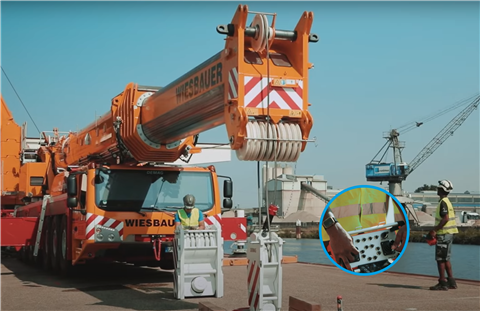 Tadano offers wireless remote control. (Photo: Tadano)
Tadano offers wireless remote control. (Photo: Tadano)
“If you get those big gusts that come through and it’ll spike on your wind speed indicator, we don’t want all of a sudden for the operator to not be able to control their load.
“We do notify everybody in the cab. We show the operator what’s going on but we don’t necessarily take that function away from them. You give them the power to do it themselves. They know when it’s not safe.
Fine metering
“Another operator aid we have is fine metering, where you can take a control or a function such as your swing or your winching up or cabling up, cabling down, or booming up, booming down.
“You can reduce it by increments of 10. So let’s say you’re at a hundred per cent and you swing left and right, you’re going to go full speed with your joysticks.
“You can ramp that down to 10 % so that when you’re operating, if you throw your joystick all the way to the left or all the way to the right, you’re only going to swing at 10 % of the speed that you normally would.
“It allows you to harness your functions to a level that’s most desirable. This is especially helpful when you’re picking up really big things. We also have telematics.
First layer, third wrap
“This is somewhat standard in the industry – first layer, third wrap. It’s an alarm that when you get down to your first layer of rope on the winch so you know when you’re running low as it can be hard to tell when operating.”
Zoning system for anti-collision
Anti-collision is still a vital system for cranes on busy work sites. It can help protect both people and equipment.
Mariano Moritsch, managing director of Moritsch Cranes, says, “Our cranes are equipped with a zoning system as a standard and on request we can provide anti-collision systems and cameras on hooks.
“These systems are used to facilitate the actions of the crane operator who works in the cabin. They increase work safety by ensuring that the cranes do not interfere with structures or other cranes on site (anti-collision) and constantly monitoring the positioning of the hook and the hanging load (cameras).
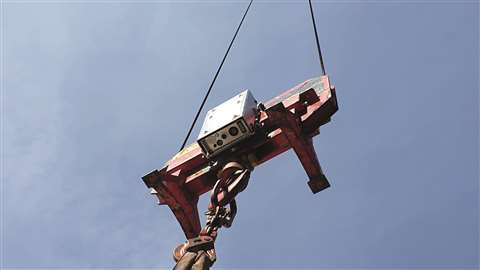 Four Moritsch luffing jib cranes in Amsterdam, Netherlands, are relying on camera systems. (Photo: Moritsch)
Four Moritsch luffing jib cranes in Amsterdam, Netherlands, are relying on camera systems. (Photo: Moritsch)
“In addition, cameras are placed directly on the hoist block to improve the quality of images and reduce vibrations.
“There is a 15 inch full HD touch display, two way audio for direct communication, a transmission antenna fixed on the jib end of the crane and equipped with a shock-absorbing tilting system to ensure constant tracking at the shooting camera fixed on the hoist block; a shooting system with thermal camera for measuring the temperature of the lifted load, useful, for example, to check the condition of the concrete.
“This is all enclosed in a protection box resistant to crushing and accidental impact. There is a night vision option and the equipment can work in temperatures from -30 to +50 °C.”
The future of operator assistance
Moritsch continues, “We are looking to develop interconnection system for cranes with remote locations through a dedicated portal to monitor the functioning of the products, guarantee a continuous service, plan maintenance activities and communicate with the operator in the cabin, alerting him, for example, to possible dangerous situations such as weather alerts. In general, operator assistance devices should be designed to become easier and easier to use.”
How can assistance devices improve efficiency?
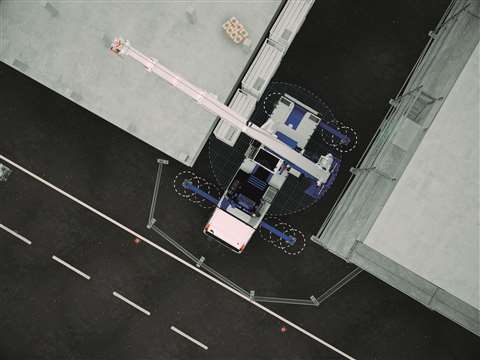 Tadano’s Surround View is useful when turning left or right and also when slewing the upper. (Photo: Tadano)
Tadano’s Surround View is useful when turning left or right and also when slewing the upper. (Photo: Tadano)
Crane manufacturer Tadano has a range of options for its different crane models, with a focus on efficiency, as well as safety.
For Tadano all terrain cranes, the company offers the IC-1 Plus. This system, Tadano says, can improve the efficiency of a crane, enabling it to perform more jobs.
Live determination of the crane capacities, depending on the slewing angle of the superstructure and the capacity radar, allow multiple asymmetric outrigger setups for work in confined spaces, especially when lifting over the outriggers.
Transport costs are reduced, since you can use less counterweight compared with 360° capacities.
Another system is the optional Tadano Surround View which offers 360° awareness. Surround View is particularly useful when turning left or right, or uncovering blind spots that may hide pedestrians, cyclists, or obstacles.
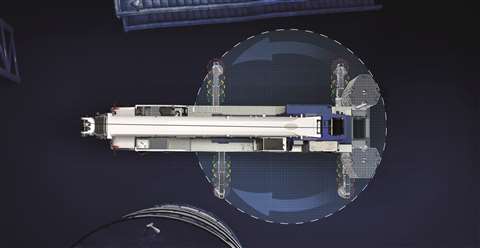 Surround view uses six crane cameras to display the possible outreach of the outriggers. (Photo: Tadano)
Surround view uses six crane cameras to display the possible outreach of the outriggers. (Photo: Tadano)
This patented system also uses the six crane cameras to display the possible outreach of the outriggers, as well as the tail swing radius at the current position of the crane in a computer-aided display. Tadano Surround View is available for the AC 2.040-1, AC 4.080-1 and AC 7.450-1 models.
Tadano’s Flex Base infinitely variable outrigger system extends the outriggers to any point within their range.
It offers the operator real-time determination for positioning right up to obstructions to achieve the largest possible outrigger base. This helps optimise lift capacities for the AC 2.040-1, AC 3.045-1 City, AC 3.055-1, AC 3.060-1, AC 4.080-1 and AC 5.130-1 all terrain cranes.
Flex Base, as the IC-1 Plus control system, automatically identifies outrigger setup, installed counterweight, superstructure angle, main boom length, and telescoping sequence.
Tadano also offers a wireless remote control and has an anti-glare monitor for all light conditions, including bright sunlight.
Obstacle detection for rough terrain cranes
For its rough terrain cranes, Tadano offers the Tadano View System as well as Clearance Sonar, which detects obstacles behind the vehicle, issuing a warning with a flashing icon on the indicator and buzzer sound.
There is the automatic pump disconnect switch to reduce fuel consumption. For the GR-1000EX-4 and GR-900EX-4 models, there is a smart counterweight system.
The counterweight can be moved between two mounting positions, increasing lifting capacity by up to 20 %.
Tadano’s smart chart boosts crane potential by expanding the conventional circular working area, improving efficiency.
Finally, there is a safety control for boom luffing operations, which prevents overload when the boom is raised to lift a load off the ground.
Assistance systems for tower cranes
Liebherr offers assistance systems across all its tower cranes. These facilitate operation, ensure a high handling capacity and increase the safety both of people and machines on the job site.
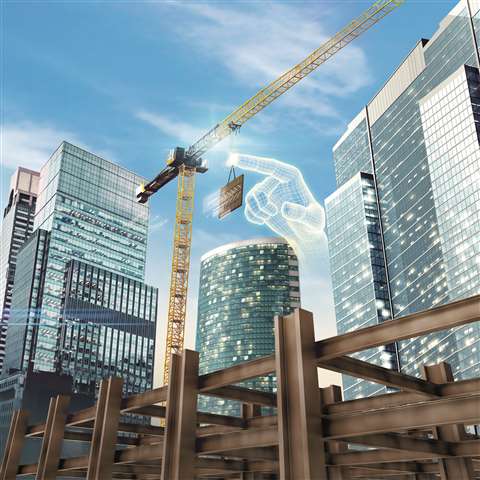 Liebherr unveiled initial prototypes of its new assistance systems at the Bauma show earlier this year. (Photo: Liebherr)
Liebherr unveiled initial prototypes of its new assistance systems at the Bauma show earlier this year. (Photo: Liebherr)
For the systems to function efficiently, they have to be in tune with the control system and components. Liebherr tower cranes use control software and drives manufactured in-house.
An example of interplay is the fine positioning mode Micromove which allows the crane operator to move heavy loads at a very slow pace to ensure precise placement without risk of damage.
Thanks to Liebherr’s drives, the assistance system can be used for several minutes at a time without the crane overheating.
Other assistance systems include an operating range limiting system (ABB), the short-term load increase function Load Plus, safety-monitored climbing and level luffing for luffing jib cranes.
Operator assistance devices at Bauma
The cranes also feature wind force control, integrated oscillation damping and adaptable slewing behaviour. Liebherr unveiled initial prototypes of its new assistance systems at the Bauma show in Munich in October.
These will be made possible with a new control system. The new assistance systems actively counteract dangerous situations.
A new feature has been added the crane operator’s cab – a 12 inch display screen. Thanks to the interface of the Tower Crane Operating System, crane operators and service technicians can navigate through a needs-based menu structure via a touch screen display.
All operating parameters relevant to their work are always in view. Display masks can be combined in various ways for this.
STAY CONNECTED


Receive the information you need when you need it through our world-leading magazines, newsletters and daily briefings.




